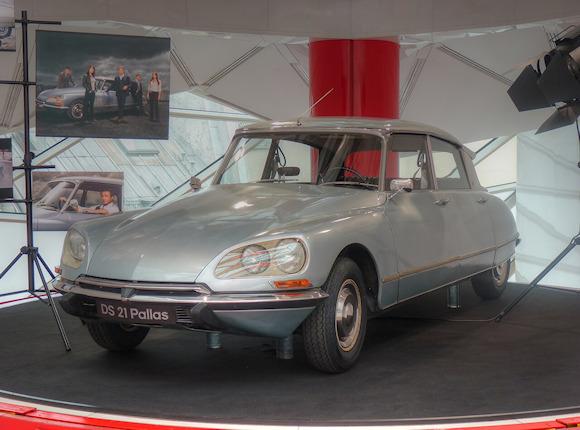At the debut of a new vehicle, features are often launched as real innovations which in reality are not very recent. If anything they have been made more efficient, safe, practical and convenient.
If we trace the history of the automotive industry, it will be curious to discover that many particular solutions date back to well before the middle of the last century. Just to give an example, let's think about low beam headlights that can be adjusted with the steering.
Fantasy and discoveries
It was Paul Magès who in 1965 equipped the first Citroën DS21 prototype (opening photo) with directional headlights connected to the steering using simple piano strings.
Then there is the central locking and here the time gap is really long. Just think that it dates back to 1914 – you understood correctly – and was created by the American car manufacturer Scripps-Booth, but it only spread to luxury cars forty years later. It was a mechanical system that later became electrical.
Even the well-known ABS system - anti-lock braking system - has as its father the very first project for the aeronautical market developed by the Frenchman Gabriel Voisin in 1929. Here a flap hit by the air regulated the pressure of the brake oil in the landing gear. Again for the aeronautical market and to limit expensive off-piste vehicles, the Maxaret – Dunlop system arrived in 1950 and only saw its elite application on cars in 70.
Even a basic dual-clutch gearbox saw its first “AutoServe” design around 1935; It was conceived by Adolphe Kégresse, who also designed electrically traction and wire-guided vehicles, as well as being the precursor of half-tracks for the Russian army.
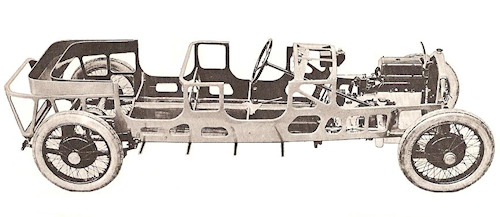 The first self-supporting body and independent suspensions saw the light in Italy in 1923 with the Lancia Lambda, while supercharging or turbo is linked to Louis Renault who already in 1902 proposed a centrifugal turbo. Alfred Buchi also filed the first supercharging project in 1905 and Lee Chadwick created the first supercharged custom-built series in 1911.
The first self-supporting body and independent suspensions saw the light in Italy in 1923 with the Lancia Lambda, while supercharging or turbo is linked to Louis Renault who already in 1902 proposed a centrifugal turbo. Alfred Buchi also filed the first supercharging project in 1905 and Lee Chadwick created the first supercharged custom-built series in 1911.
It should be noted that many solutions were created for the military market, among the first to equip themselves with significant motorization, making the movement of departments more efficient, while for others it was not considered convenient to develop them.
A big name: General Motors
Remaining in the last century which in some ways represented an industrial enlightenment phase, there is even a noteworthy detail linked to a prestigious car manufacturer, Pontiac. If I asked you to imagine a transmission shaft, your thought would almost certainly fall on a circular and solid steel profile, perhaps with some cardan joints, like those you see at the traffic lights when looking at the trucks alongside us.
The Pontiac Tempest
Well, in 1961 with a nickel chromium molybdenum alloy – SAE 8660 – the American Pontiac, General Motors group, created for the Tempest the first flexible transmission nicknamed “rope transmission”. In reality there was no rope but no joint either. In fact, the shaft showed a natural flexion when leaving the engine to reach the gearbox located at the rear, as in the diagrams transaxle.
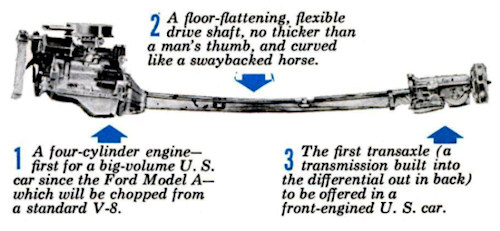 I try to get technical in simple words by describing the system Tempest which included a boxed seat for the transmission shaft measuring 2,20 m (87,25 in) in length and a few centimeters in diameter. Its "elastic" characteristics also absorbed engine vibrations, but the location of the automatic gearbox is unique. The torque converter donut was exposed behind the differential and could be seen rotating after receiving rotational thrust from the shaft. It is presumable that it was subject to impacts, however the small diameter of the transmission shaft had its reason. In fact, it essentially had to operate and overcome only the hydraulic resistance of the converter's semi-torque pump, not mechanically move the primary of a manual gearbox as in the Alfa Romeo transaxle scheme.
I try to get technical in simple words by describing the system Tempest which included a boxed seat for the transmission shaft measuring 2,20 m (87,25 in) in length and a few centimeters in diameter. Its "elastic" characteristics also absorbed engine vibrations, but the location of the automatic gearbox is unique. The torque converter donut was exposed behind the differential and could be seen rotating after receiving rotational thrust from the shaft. It is presumable that it was subject to impacts, however the small diameter of the transmission shaft had its reason. In fact, it essentially had to operate and overcome only the hydraulic resistance of the converter's semi-torque pump, not mechanically move the primary of a manual gearbox as in the Alfa Romeo transaxle scheme.
Then there was the gearbox operated by the valve body in line with the differential; these are the elements of effective effort and mechanical stress.
The movement of the engine reached the transmission which entered the "gearbox bell" via sliding shafts inserted into each other and independent of each other. Here the movement of the engine reached the converter pump directly which, after the hydraulic multiplication of torque, sent the oil back onto the turbine which activated the epicycles then connected to the differential.
That's a scheme transaxle, which rewarded the Tempest for road holding, bringing this 60s USA sedan closer to the popular European car concept. In fact, its relatively economical 4-cylinder in-line engine (only a V8 as an option) was actually admired by many Yankee customers who in those years could not count on European automotive offerings except for the small Beetle il Beetle, landed in New York in '49.
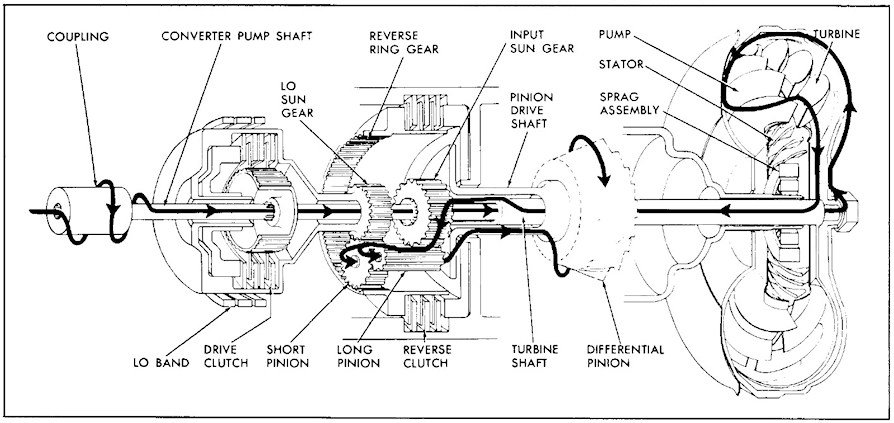
Military solutions
There is little and sometimes unreliable news from the industries but, as always, the best feedback comes from the users, the military. The importance of an efficient transmission system for a military vehicle is therefore not negligible as it can determine the stopping of the vehicle or its continuation, perhaps in war and during a hasty retreat.
The underbody of armored vehicles are protected, but it is not enough, in this case it is necessary to segment and remove the transmission shafts laterally to prevent them from becoming lethal in the event of a strong explosion, a concept followed on the VTLM2 Lynx.
The shape of the transmission on armored vehicles with a hull is concentrated, above all for reasons of space, on the double shaft - one on each side - called H-shaft with transmissions that reach the individual 6 or 8 wheels.
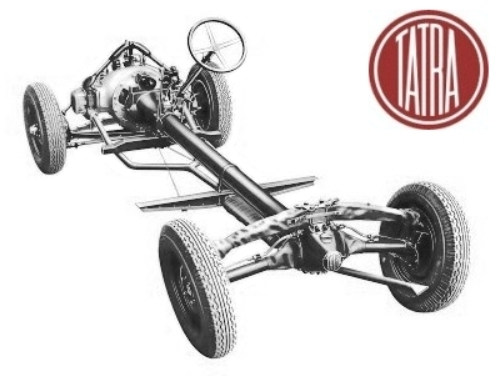 In the Czech Republic, home of Tatra Trucks, the concept is different, and it is the famous and historic central longitudinal "tube" (T11 and T12 from 1923) that encloses and houses all the motion transmission components.
In the Czech Republic, home of Tatra Trucks, the concept is different, and it is the famous and historic central longitudinal "tube" (T11 and T12 from 1923) that encloses and houses all the motion transmission components.
Bureaucracy and updates
In light of the technological development of the inventions we have seen, there is a point in which Italy is terribly behind despite the important efforts and economic interests (?) in the defense sector: implementation based on current needs; a condition which sees automotive inventions already overcome (and not due to a lack of international offers) when they reach final operation.
Perhaps it would be worth it, given that it concerns public money, to make use of a clause that establishes the interruption of onerous expenses when operating times are exceeded, there are doubts about the usefulness or, funds are required to update what is already clearly outdated, see the story of the chariots Ram.
Photo: Romain DC / web / Tatra

